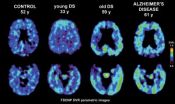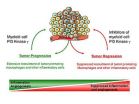(Press-News.org) A team of researchers, led by Emmanuel Nivet, now at the Salk Institute for Biological Studies, La Jolla, has generated data in mice that suggest that adult stem cells from immune system tissue in the smell-sensing region of the human nose (human olfactory ecto–mesenchymal stem cells [OE-MSCs]) could provide a source of cells to treat brain disorders in which nerve cells are lost or irreparably damaged.
Stem cells are considered by many to be promising candidate sources of cells for the regeneration and repair of tissues damaged by various brain disorders (including traumatic brain injury). There are two types of stem cell usually considered in this therapeutic context: embryonic stem (ES) cells, which are derived from early embryos; and induced pluripotent stem (iPS) cells, which are derived by reprogramming cells of the body such that they have the ability to generate any cell type. Ethical and technical issues have so far limited clinical development of therapeutic approaches using ES and iPS cells, respectively, meaning that researchers are seeking alternative stem cell sources. Nivet and colleagues found that upon transplantation into mice with damage to the hippocampal region of their brain (a region important for learning and memory) OE-MSCs moved toward the site of damage, where they developed into nerve cells and also stimulated endogenous nerve cell generation. Importantly, the treated mice showed improvement in learning and memory. These data suggest OE-MSCs might be of tremendous utility in the clinic.
###
TITLE: Engraftment of human nasal olfactory stem cells restores neuroplasticity in mice with hippocampal lesions
AUTHOR CONTACT:
Emmanuel Nivet
Salk Institute for Biological Studies, La Jolla, California, USA.
Phone: 858.453.4100, ext. 1324; Fax: 858.453.2573; E-mail: enivet@salk.edu.
View this article at: http://www.jci.org/articles/view/44489?key=4b09fd39d7a54a394fb1
Sniffing out a new source of stem cells
2011-06-14
ELSE PRESS RELEASES FROM THIS DATE:
JCI online early table of contents: June 13, 2011
2011-06-14
EDITOR'S PICK: Sniffing out a new source of stem cells
A team of researchers, led by Emmanuel Nivet, now at the Salk Institute for Biological Studies, La Jolla, has generated data in mice that suggest that adult stem cells from immune system tissue in the smell-sensing region of the human nose (human olfactory ecto–mesenchymal stem cells [OE-MSCs]) could provide a source of cells to treat brain disorders in which nerve cells are lost or irreparably damaged.
Stem cells are considered by many to be promising candidate sources of cells for the regeneration and repair ...
Brain scan identifies patterns of plaques and tangles in adults with Down syndrome
2011-06-14
In one of the first studies of its kind, UCLA researchers used a unique brain scan to assess the levels of amyloid plaques and neurofibrillary tangles — the hallmarks of Alzheimer's disease — in adults with Down syndrome.
Published in the June edition of the Archives of Neurology, the finding may offer an additional clinical tool to help diagnose dementia in adults with Down syndrome, a genetic disorder caused by the presence of a complete or partial extra copy of chromosome 21.
Adults with this disorder develop Alzheimer's-like plaque and tangle deposits early, ...
Chillingham cattle cowed by climate change
2011-06-14
Spring flowers are opening sooner and songbirds breeding earlier in the year, but scientists know little about how climate change is affecting phenology – the timing of key biological events – in UK mammals. Now, a new study on Northumberland's iconic Chillingham cattle published in the British Ecological Society's Journal of Animal Ecology shows climate change is altering when these animals breed, and fewer calves are surviving as a result.
The team of ecologists lead by Dr Sarah Burthe of the Centre for Ecology & Hydrology were able to use the cattle to discover more ...
Pacemaker implantation for heart failure does not benefit nearly half of the patients
2011-06-14
A new meta-analysis study, led by physician researchers at University Hospitals (UH) Case Medical Center and Case Western Reserve University School of Medicine, and to be published in the Archives of Internal Medicine (embargoed until June 13, 4 p.m. EDT), shows that three-lead cardiac pacemakers implanted in those with heart failure fail to help up to 40 percent of patients with such devices.
"These findings have significant clinical implications and impact tens of thousands of patients in the U.S.," said Ilke Sipahi, MD, Associate Director of Heart Failure and Transplantation ...
Genetic factor controls health-harming inflammation in obese
2011-06-14
CLEVELAND – June 13, 2011 –Researchers at Case Western Reserve University School of Medicine have discovered a genetic factor that can regulate obesity-induced inflammation that contributes to chronic health problems.
If they learn to control levels of the factor in defense cells called macrophages, "We have a shot at a novel treatment for obesity and its complications, such as diabetes, heart disease and cancer," said Mukesh K. Jain, MD, Ellery Sedgwick Jr. Chair, director of the Case Cardiovascular Research Institute, professor of medicine at Case Western Reserve University ...
Promising new target for stifling the growth and spread of cancer
2011-06-14
Cancer and chronic inflammation are partners in peril, with the latter increasing the likelihood that malignant tumors will develop, grow and spread. Researchers at the University of California, San Diego School of Medicine say they've identified a tumor inflammation trigger that is common to most, if not all, cancers. And using existing inhibitory drugs, the scientists were able to dramatically decrease primary tumor growth in animal studies and, more importantly, halt tumor progression and metastasis.
The findings appear in the June 14 issue of the journal Cancer Cell, ...
Type 2 diabetes linked to higher risk of stroke and CV problems; metabolic syndrome isn't
2011-06-14
CHICAGO – Among patients who have had an ischemic stroke or transient ischemic attack (TIA), type 2 diabetes was associated with an increased risk of recurrent stroke or cardiovascular events, but metabolic syndrome was not, according to a report published Online First today by Archives of Neurology, one of the JAMA/Archives journals.
Previous research has examined the association between cardiovascular incidents and these conditions, according to background information in the article. "Type 2 diabetes mellitus is associated with increased risks of both stroke and coronary ...
Expenditures for glaucoma medications appear to have increased
2011-06-14
CHICAGO – In recent years, spending for glaucoma medications has increased, especially for women, persons who have only public health insurance and those with less than a high school education, according to a report published Online First by Archives of Ophthalmology, one of the JAMA/Archives journals.
Glaucoma is a condition marked by damage to the optic nerve, and is a leading cause of blindness. According to background information in the article, approximately 2.2 million individuals ages 40 years and older in the United States currently have primary open-angle glaucoma; ...
Dietary changes appear to affect levels of biomarkers associated with Alzheimer's disease
2011-06-14
###
(Arch Neurol. 2011;68[6]:743-752. Available pre-embargo to the media at www.jamamedia.org.)
Editor's Note: This research was supported by grants from the National Institute on Aging and by funding from the Nancy and Buster Alvord Endowment. This article results from work supported by resources from the Veterans Affairs Puget Sound Health Care System. Please see the article for additional information, including other authors, author contributions and affiliations, financial disclosures, funding and support, etc. ...
Study estimates potential for ranibizumab to prevent blindness from age-related macular degeneration
2011-06-14
A computer modeling study suggests that administering the drug ranibizumab is associated with reducing the magnitude of legal blindness and visual impairment caused by age-related macular degeneration in non-Hispanic white individuals, according to a report in the June issue of Archives of Ophthalmology, one of the JAMA/Archives journals.
"Before ranibizumab became available in 2006, neovascular age-related macular degeneration (AMD) was reported to be the leading cause of blindness in individuals 50 years and older in the United States and throughout many parts of the ...


